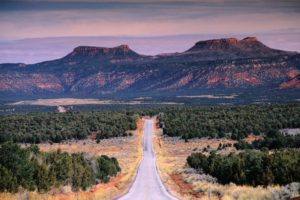President Trump has announced significant changes in the boundaries of several National Monuments, including the two most controversial in the West: Bears Ears and Grand Staircase-Escalante, both in Utah. Whichever side of this controversy you are on, there is no bigger news in the West this month. Based on recommendations from Interior Secretary Ryan Zinke, the announcement also had the support of Utah’s governor, Congressional delegation, and local elected officials.
 The result is that instead of two huge monuments, there will now be five, totaling 1.2 million acres. Within those areas, Native American artifacts and other objects of historic or scientific interest will remain protected, while in the two million acres released from the monuments, traditional uses and public access will be restored.
The result is that instead of two huge monuments, there will now be five, totaling 1.2 million acres. Within those areas, Native American artifacts and other objects of historic or scientific interest will remain protected, while in the two million acres released from the monuments, traditional uses and public access will be restored.
As expected, environmental groups immediately sued. They may find sympathetic judges and get an initial ruling favorable to their viewpoint, and it’s hard to blame them for trying. Monument designations have been among their favorite tools for stopping various projects. Still, it is highly unlikely they will prevail in the end, for one simple reason – the President has every legal right to do what he did, whether you agree with his decision or not.
That is one of several major issues raised by critics this week, including the Sentinel, questioning the legality of Trump’s action. The Sierra Club and others called it “legally unprecedented.” But Presidents of both parties have, in fact, shrunk the boundaries of national monuments – eighteen times – and their authority to do so has never been questioned. Most recently, President Kennedy reduced the acreage of both Bandelier and Natural Bridges National Monuments. Presidents Taft, Wilson, and Coolidge all shrunk Mount Olympus National Monument, and President Eisenhower reduced four monuments, including Great Sand Dunes in Colorado.
Another disturbing accusation by critics is that these lands will no longer be protected. One Washington Post report highlighted a statement that appeared on Patagonia’s website that day, “The President stole your land!” Eliminating federal protection for resources we all care about sounds troubling, if it were true. It is not. All of these lands – every square inch – remain in federal ownership, under continued management by the BLM, Forest Service, and Park Service. Not one acre is being sold, privatized, transferred to states, or “stolen” by anyone. This is a change in the management structure, nothing more. Any development of any resource still requires federal permits, as on all federal lands.
Finally, opponents accuse Secretary Zinke of making the recommendations in secret, without meeting with stakeholders. Ironically, the Washington Post also just ran a story glorifying John D. Rockefeller, Jr.’s secret land deals (in collusion with the Interior Dept.), which enabled FDR to give national monument status to once-private land in Jackson Hole. In contrast, Secretary Zinke made these recommendations after visiting eight monuments in six states, personally hosting over 60 meetings attended by hundreds of local stakeholders on all sides, including environmental organizations (even some of those suing him now), county commissioners, and numerous local residents. He also met with Tribal representatives, including the Bears Ears Inter-Tribal Coalition, and several others on both sides.
A vital point is lost in so much of this debate – the difference between these monuments, and the hundreds of others across the country. Most were created by Presidents in response to local pleas. My home town of Grand Junction has always been proud of the efforts of a local pioneer named John Otto, who labored for years in the early 20th Century to secure designation of the Colorado National Monument. His campaign, like so many others across the nation, united communities, chambers of commerce, local newspapers, service clubs, towns, counties, and congressional delegations, all trying to gain presidential recognition. That was the process, until recently.
Grand Staircase-Escalante was a surprise attack, as were Bears Ears and several others, created during their last weeks in office by Presidents Clinton and Obama. They were created over the objections of local communities, not at their request. Their purpose was to stop specific uses of the public lands, upon which those communities depend.
Like most westerners, I am offended by a federal arrogance in recent years, an attitude that doesn’t trust the people to care for public lands in their own communities. People who think we would destroy these magnificent places do not understand our deep attachment to the land – nor the common-sense adage that “no one cares more about my back yard than I do.”
In this week’s announcement, the President said, “No one values the splendor of Utah more than the people of Utah – and no one knows better how to use it… and they will preserve it for generations to come.” How refreshing, to hear someone in Washington acknowledge the obvious, and at least begin to recall a tradition of partnership with westerners in the management of public lands.
A version of this column originally appeared in the Grand Junction Daily Sentinel December 8, 2017.




Comments on this entry are closed.